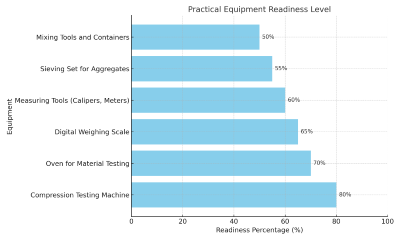Infrastructure Readiness for Blended Learning in Vocational Higher Education: A Case Study from the Faculty of Engineering, Universitas Negeri Padang
DOI:
https://doi.org/10.24036/cived.v12i1.674Keywords:
Blended Learning, Infrastructure Readiness, Vocational Education, Industry 4.0, COVID-19Abstract
The evolution of technology and the COVID-19 pandemic have accelerated the adoption of blended learning in higher education, including in vocational institutions. However, infrastructure readiness plays a pivotal role in the success of this implementation, especially in practice-based technical education. This study aims to assess the level of infrastructure readiness for supporting blended learning at the Faculty of Engineering, Universitas Negeri Padang, and to identify supporting and hindering factors. A quantitative descriptive survey method was used, with data collected through observations, interviews, and document analysis. The results showed that the infrastructure readiness level reached 65.11%, indicating moderate compliance with national standards as outlined in the Ministry of Education Regulation No. 3/2020. The main challenges identified include mismatches between equipment procurement and space availability, limited internet connectivity, and underutilized e-learning applications. Supporting factors included increased digital devices, provision of internet data for students and lecturers, and improvements in e-learning platforms. These findings highlight the need for continuous reinforcement of digital infrastructure to ensure the effectiveness of blended learning in the post-pandemic era.
Downloads
References
I. E. Allen and J. Seaman, Digital Learning Compass: Distance Education Enrollment Report 2017, Babson Survey Research Group, 2017.
D. R. Garrison and N. D. Vaughan, Blended Learning in Higher Education: Framework, Principles, and Guidelines, Jossey-Bass, 2008.
V. Arkorful and N. Abaidoo, “The role of e-learning, advantages and disadvantages of its adoption in higher education,” Int. J. Instr. Technol. Distance Learn., vol. 12, no. 1, pp. 29–42, 2015.
C. Hodges, S. Moore, B. Lockee, T. Trust, and A. Bond, “The difference between emergency remote teaching and online learning,” Educause Review, Mar. 2020. [Online]. Available: https://er.educause.edu/articles/2020/3/the-difference-between-emergency-remote-teaching-and-online-learning
OECD, The State of Global Education: 18 Months into the Pandemic, Paris: OECD Publishing, 2021. [Online]. Available: https://doi.org/10.1787/1a23bb23-en
H. Wahyono, H. Husamah, and D. Setyawan, “Blended learning dalam pendidikan vokasi: Studi kasus pada program studi teknik bangunan,” J. Pendidik. Teknol. dan Kejuruan, vol. 26, no. 1, pp. 14–22, 2020.
Dirjen Dikti, Panduan Penyusunan Kurikulum Pendidikan Tinggi di Era Industri 4.0 untuk Mendukung Merdeka Belajar–Kampus Merdeka, Kemendikbud, 2020.
B. Means, Y. Toyama, R. Murphy, and M. Baki, “The effectiveness of online and blended learning: A meta-analysis of the empirical literature,” Teachers College Record, vol. 115, no. 3, pp. 1–47, 2013.
M. Bond, K. Buntins, S. Bedenlier, O. Zawacki-Richter, and M. Kerres, “Mapping research in student engagement and educational technology in higher education: A systematic evidence map,” Int. J. Educ. Technol. High. Educ., vol. 18, no. 1, pp. 1–30, 2021. https://doi.org/10.1186/s41239-021-00249-7
M. Hasan and N. Lestari, “Kendala pembelajaran daring pada masa pandemi COVID-19 di pendidikan vokasi,” J. Pendidik. Vokasi, vol. 10, no. 2, pp. 153–160, 2020.
M. I. Husain and S. G. Spicer, “Disparities in online education: Internet access and the digital divide,” Educ. Inf. Technol., vol. 27, pp. 3211–3232, 2022. https://doi.org/10.1007/s10639-021-10641-6
R. K. Dewi, “Evaluasi kesiapan sarana dan prasarana dalam pelaksanaan pembelajaran daring di masa pandemi COVID-19,” J. Pendidik. dan Pembelajaran, vol. 27, no. 2, pp. 89–97, 2021.
Z. I. Almarzooq, M. Lopes, and A. Kochar, “Virtual learning during the COVID-19 pandemic: A disruptive technology in graduate medical education,” J. Am. Coll. Cardiol., vol. 75, no. 20, pp. 2635–2638, 2020. https://doi.org/10.1016/j.jacc.2020.04.015
Kemendikbud, Peraturan Menteri Pendidikan dan Kebudayaan Republik Indonesia Nomor 3 Tahun 2020 tentang Standar Nasional Pendidikan Tinggi, Jakarta: Kemendikbud RI, 2020.
A. Fini, “The technological dimension of a Massive Open Online Course: The case of the CCK08 course tools,” Int. Rev. Res. Open Distance Learn., vol. 10, no. 5, pp. 1–26, 2009. https://doi.org/10.19173/irrodl.v10i5.643
G. Basilaia and D. Kvavadze, “Transition to online education in schools during a SARS-CoV-2 coronavirus pandemic in Georgia,” Pedagog. Res., vol. 5, no. 4, em0060, 2020. https://doi.org/10.29333/pr/7937
P. Putra, F. Y. Liriwati, T. Tahrim, S. Syafrudin, and A. Aslan, “The students learning from home experience during COVID-19 school closures policy in Indonesia,” J. Iqra’, vol. 5, no. 2, pp. 30–42, 2020. https://doi.org/10.25217/ji.v5i2.1019
P. Utari, Sutrisno, and A. Suryadi, “Strategi pembelajaran daring pada pendidikan kejuruan berbasis filosofi pendidikan vokasi,” J. Pendidik. Teknol. dan Kejuruan, vol. 27, no. 1, pp. 11–21, 2021.
World Bank, Remote Learning During the Global School Lockdown: Multi-Country Lessons, Washington, DC: The World Bank, 2020. https://doi.org/10.1596/33405
R. Khalil et al., “The sudden transition to synchronized online learning during the COVID-19 pandemic in Saudi Arabia: A qualitative study exploring medical students’ perspectives,” BMC Med. Educ., vol. 20, no. 1, pp. 285, 2020. https://doi.org/10.1186/s12909-020-02208-z

Downloads
Published
How to Cite
Issue
Section
License
Copyright (c) 2025 Nelvi Salendra, M. Giatman, Nurhasan Syah, Aswardi

This work is licensed under a Creative Commons Attribution 4.0 International License.







2.jpg)
